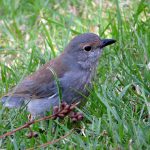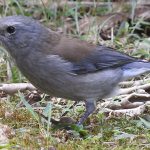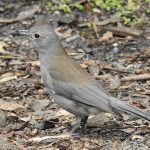GREY SHRIKE-THRUSH
The Grey Shrike-thrush is a songbird with a reputation for its melodious vocalisations, which are as harmonious as its scientific name suggests. This bird is a resident of Australia and can also be found in the southern parts of New Guinea.
The Grey Shrike-thrush is a medium-sized bird, with adults typically reaching around 24 cm in length. They have a subtle beauty, with soft grey plumage on their back and a lighter grey to white on their underparts. Their wings are rounded, and they have a long tail which they often fan out. Their bill is robust and black, perfect for their omnivorous diet.
These birds are quite versatile in their choice of habitat. They can be found in a range of environments, from rainforests and eucalyptus groves to parks and gardens. They have a preference for wooded areas, where they can forage among the leaf litter or bark for their food.
The Grey Shrike-thrush is an opportunistic feeder. Its diet is impressively varied, including insects, spiders, small reptiles, and even other smaller birds. They are also known to consume seeds and fruits, making them an important part of the ecosystem for seed dispersal.
These birds are not just skilled hunters but also curious explorers. They are known to investigate their surroundings thoroughly, sometimes even tapping on tree trunks and branches to flush out hidden insects. They are generally solitary or found in pairs, and while they may not be the most social birds, their presence is certainly felt through their song.
When it comes to nesting, the Grey Shrike-thrush is quite traditional, with a preference for a hollow in a tree or a similar natural feature. They line their nests with soft materials, and the female will lay 2 to 3 eggs, which both parents then incubate.
They are widespread across Australia, excluding some of the aridest areas in the centre and the west. Their range extends from the coastal regions of Queensland, New South Wales, Victoria, South Australia, and the island state of Tasmania, as well as parts of Western Australia.
In summary, the Grey Shrike-thrush is a testament to the diversity and adaptability of Australian wildlife. Its beautiful song and presence across various habitats make it a beloved feature in the Australian soundscape. As we learn more about these birds, we’re reminded of the importance of preserving the natural environments that allow such species to thrive. Through understanding and appreciation, we can ensure that the harmonious call of the Grey Shrike-thrush continues to resonate through the Australian landscape for generations to come.



